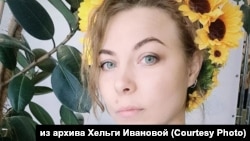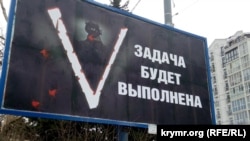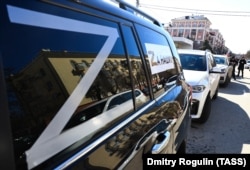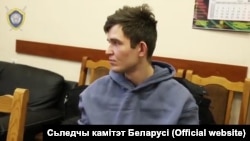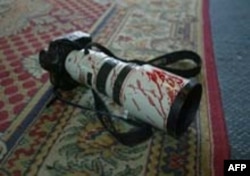
At a session of the municipal legislature in the Siberian city of Novosibirsk on March 16, independent lawmaker Khelga Pirogova appeared wearing Ukrainian folk motifs and a garland of sunflowers. She stood out among about two dozen ruling United Russia party deputies who wore black masks with the image of a bear and the Latin letter Z.
Since the Russian invasion of Ukraine on February 24, and particularly in the last two weeks or so, the letter Z has become the increasingly ubiquitous symbol of support for the war, for the military, for the Kremlin’ s policies, and most of all for President Vladimir Putin.
However, many in Russia and abroad have grown increasingly concerned about the often aggressively brandished symbol, which they see as a fascistic emblem of state-mandated blind loyalty and a militarized society.
Political commentator Vitaly Portnikov labeled the Z symbol a "stylized semi-swastika" and other commentators have taken to referring to it as the "Zwastika."
At the Novosibirsk meeting, Pirogova introduced a question into the agenda, asking how much the city had spent to plaster the Z symbol all over the city, including on buses and other public transport.
"I have been getting rather a lot of messages from residents who are asking that something be done about this symbol," Pirogova told RFE/RL's Siberia.Realities. "They don't like it. It arouses in them anxiety, fear, and other negative emotions."
Deputy City Council Chairman Yevgeny Yakovenko launched into a blistering attack on Pirogova and others who oppose the war, denouncing them as "national traitors" who deserve to be sentenced to hard labor.
The Z symbol, Yakovenko said, "fills me with only a feeling of gratitude for our president and for our armed forces because they were able to protect Russia from invasion."
The symbol originated when people noticed the letter Z painted on many of the Russian military vehicles that have poured into Ukraine over the past three weeks. Although the Russian military has not explained the use of the letter, analysts believe it is used to indicate forces from the Western (zapadny) Military District. Other vehicles bore different symbols that seemed to refer to the Eastern, Southern, and Central military districts. The markings helped distinguish Russian equipment from similar equipment used by the Ukrainian armed forces, as well as to clarify lines of command.
"About a week after the beginning of the war, the Kremlin propagandists decided to take the symbol Z, which already had mythical associations, into their arsenal for propaganda purposes," said Ruslan Leviyev, a military analyst at the Conflict Intelligence Team, an independent monitoring group. "Then they thought up various rather simplistic explanations such as that Z stands for ‘For Victory’ (za pobedu in Russian)."
To a lesser extent, the Latin letter V (for eastern, vostochny) has also been used in the same way.
Leviyev noted that Z has become a Kremlin "brand," similar to the orange-and-black St. George ribbons that Putin’s government has promoted heavily in connection with the commemorations of the Soviet contributions to victory in World War II. The ribbons were also used to signify support for the previous Russian incursion into Ukraine in 2014.
A Brand Appears
Over the last few weeks, the Z symbol has cropped up everywhere. The Central Election Commission has managed to work it into its logo. Kemerovo Oblast Governor Sergei Tsivilyov has ordered that all official references to the region known as the Kuzbass be written using the Latin Z:, KuZbass. The Far Eastern Zabaikalye region adopted a similar measure.
The Kremlin has barred Russians from calling the war in Ukraine a war, insisting that they use the term “special operation.” The state television channel RT has been officially calling the war in Ukraine "Special Operation Z" and has been marketing t-shirts with the Z logo. A Russia-based online shop, Wildberries, has been selling a whole line of Z-related products, including window stickers for cars.
Riot police around the country have begun sporting the insignia on their black helmets.
At state-run institutions, numerous well-organized "flash mobs" featuring the Z symbol have taken place, many of them involving students or schoolchildren. In Kazan, the capital of Tatarstan, patients at a children's hospice stood in the Z formation in the snow, while in Khakasia, schoolchildren were photographed kneeling with signs bearing the St. George ribbon in the shape of the Z.
"Russia is moving in the direction of clinical madness," said Moscow-based political analyst Dmitry Oreshkin in an interview with RFE/RL's Ukrainian Service. "I couldn't imagine that there would be a war, but it has happened. This means that I am living in some other reality that is not accessible to my understanding."
From Symbols To 'Traitors'
Russian philosopher and essayist Mikhail Epstein, who teaches at Emory University in the United States, has described contemporary Russian society as "schizo-fascism," which he defines as "fascism that is hiding under the mask of fighting against fascism."
"Schizo-fascism is a fragmented world view, sort of a caricature of fascism," he said in an interview with RFE/RL's North.Realities. "But it is a serious, dangerous, and aggressive caricature. Schizo-fascism is an hysterical hatred of freedom, democracy, everything foreign, and of people identified as 'others.' It is constantly seeking enemies and traitors."
Putin seemed to reinforce this impression with an alarming speech to government ministers during a March 16 video conference in which he lambasted so-called "national traitors."
"Any nation, in particular the Russian nation, will always be able to distinguish true patriots from scum and traitors and will simply spit them out like a fly that has accidentally flown into their mouths,” Putin said. "I am convinced that a natural and necessary self-purification of society will only strengthen our country, our solidarity, cohesion, and readiness to answer any challenges."
The online student publication Doxa reported on March 16 that the Z symbol and accusations of treason were spray-painted on the residences of Moscow student activists Dmitry Ivanov and Olga Misik. There were reports of similar intimidation techniques deployed against activists in St. Petersburg.
The personal data of anti-war demonstrators has reportedly been posted on social media channels. Human rights lawyer Daniil Berman posted on Facebook on March 17 that the Investigative Committee in Moscow has been informally ordered to wind up all "economic cases" as quickly as possible because "in April they will all be inundated with criminal cases against 'enemies of the state' and 'national traitors.'"
A White Rose
Meanwhile, some Russians who oppose the war have taken inspiration from the few courageous individuals who took stands against the fascist regime of Adolf Hitler in Germany.
In the Siberian city of Irkutsk on March 16, a lone protestor stood on a central square silently holding a single white rose.
It was tribute to the White Rose student movement in Munich in the early 1940s that distributed leaflets calling for resistance to the Nazi regime.
The group's three main leaders – the brother and sister Hans and Sophie Scholl and their friend, Christoph Probst – were executed by guillotine four days after their arrest, on February 22, 1943.




